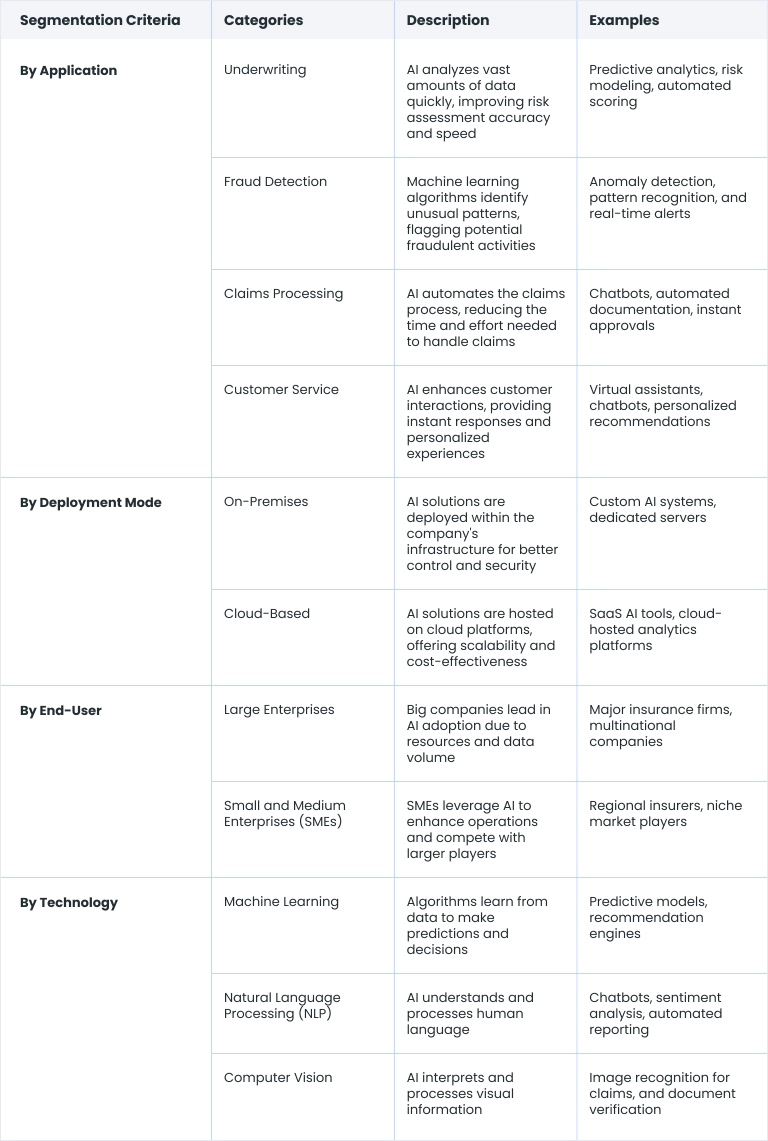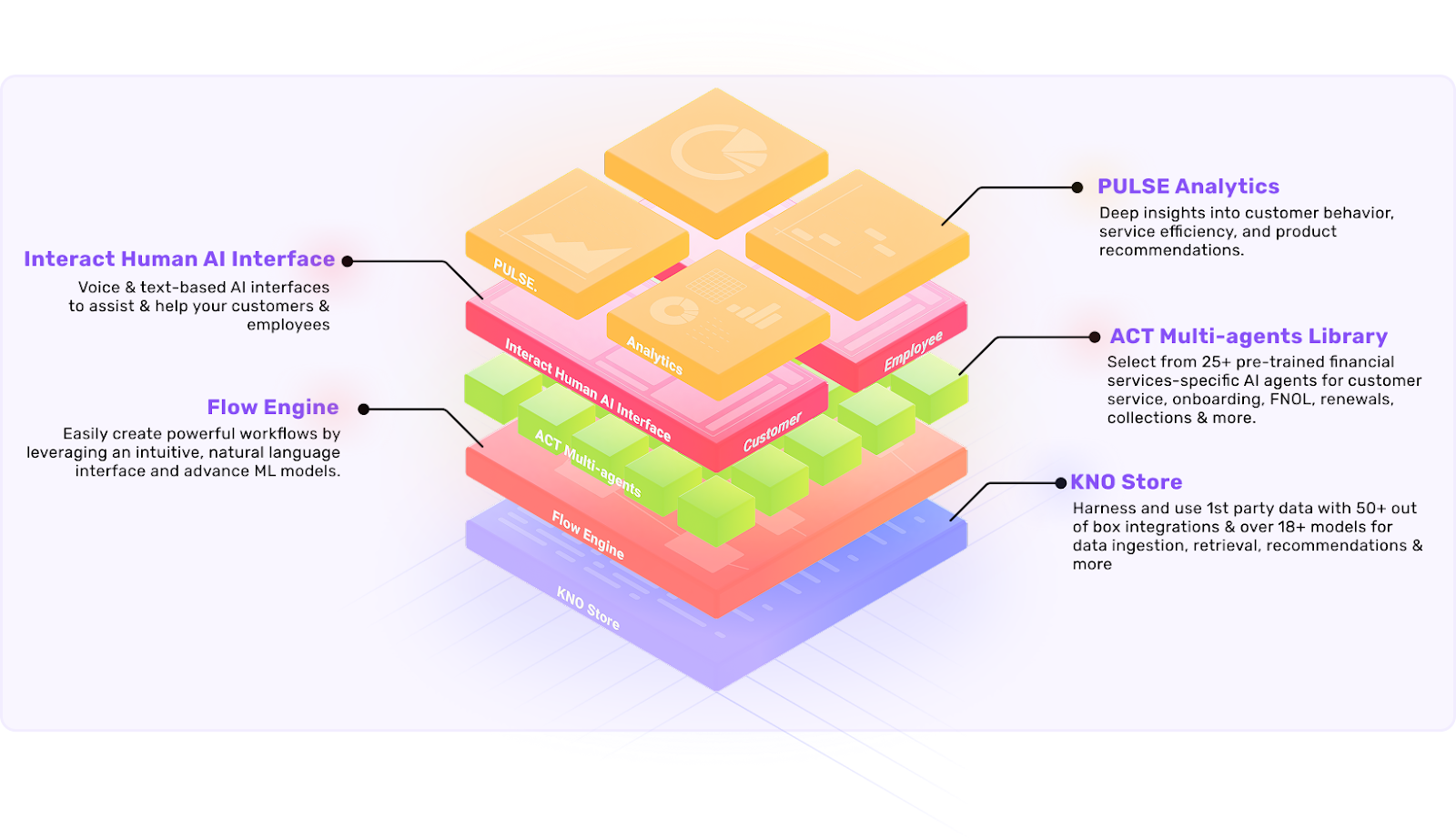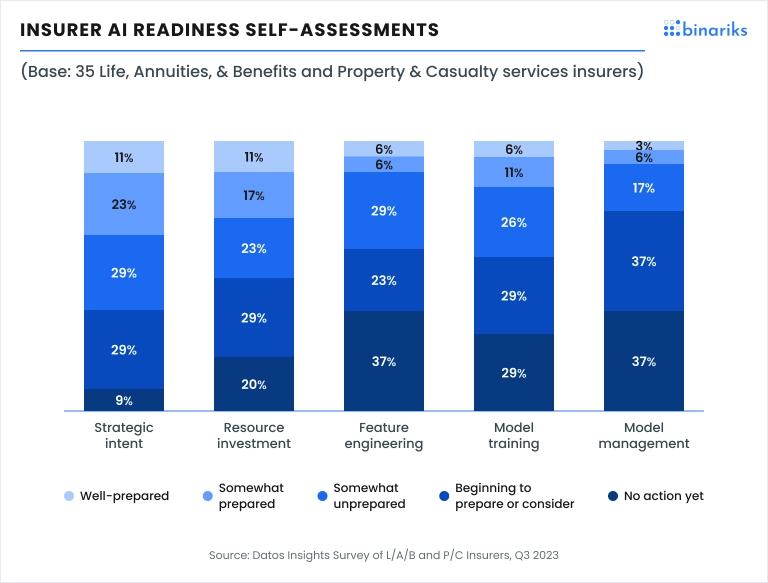© 2025 Alltius Inc
The insurance industry isn’t short on challenges— from legacy systems and siloed operations to rising customer expectations and regulatory changes. And let’s be honest, the pace at which insurers are expected to modernize can feel like running a marathon on a treadmill set to sprint.
But here’s the thing—you don’t need more dashboards, data dumps, or “intelligent” platforms.
You need clarity.
You need speed.
You need agility.
That’s where Alltius’s AI + Agility Layer comes in.
It’s not just another automation feature or chatbot wrapped in fancy branding.
Alltius combines generative intelligence with a unique agility insurance layer to simplify complex workflows, eliminate swivel-chair operations, and empower your teams to act faster—whether it's underwriting, claims, distribution, or servicing.
This agility layer is the bridge between large-scale decision systems and front-line execution. Think of it as the operational connective tissue that knows when to think, when to decide, and when to act.
Before we move forward—what is Agility?
Agility is not a buzzword.
But the kind of concept that actually matters when you’re handling sensitive, regulated, high-context workflows like insurance and lending.
Agility, in this world, isn’t about speed alone.
It’s about being able to sense, decide, and act—all within the flow of work. Without bouncing across 6 tools. Without pausing for a playbook. Without waiting for a supervisor sign-off every time a new condition pops up.
In short:
Agility is your team’s ability to respond with intelligence, not just react with process.
And that’s where the real transformation starts.
The insurance landscape is evolving at an unprecedented pace. According to McKinsey’s 2025 Global Insurance Report, digital-first insurers grow revenues 2-3x faster than traditional peers. Yet, fewer than 20% of incumbents have successfully operationalized agility at scale.
The concept of agility insurance transcends digitization. It is the capacity of insurers to:
Bain’s research confirms that firms with agile operations report up to39% success rate, driven by faster, more accurate service delivery.
Insurers lagging behind this curve risk losing market share to InsurTech disruptors and digital-native entrants who embed agility into their DNA.
Let’s talk numbers. Because while agility insurance sounds good in theory, it’s the ROI that matters.
So what’s missing?
Agiliability.
(Yes, it’s a made-up word—but bear with us.)

Before we move forward, it’s worth asking:
Why does this architecture make sense—beyond the buzzwords?
Because in regulated, high-context environments like insurance and lending, the problem isn’t that teams lack intelligence.
The problem is they’re surrounded by systems that are informationally rich but operationally brittle.
What Alltius enables is a reconfiguration of that brittleness—into a dynamic, intelligent, and adaptive layer that can keep up with how work actually gets done. Let’s unpack how:

Insurance and lending are built on context—yet most enterprise systems only read structured fields.
The Hybrid Data Layer bridges this gap by fusing:
This isn’t just technical plumbing. It’s the foundation of decisions that reflect reality, not just rows in a database.
According to 2023 research, organizations leveraging hybrid data layers saw a 27% increase in first-pass automation accuracy, primarily by reducing blind spots in contextual understanding.
In claims, it means agents don’t miss subrogation cues buried in adjuster notes.
In lending, it means borrower intent is inferred from emails—not just application fields.
This is the execution layer where intelligence meets agency.
Unlike simple chat interfaces or monolithic workflows, Alltius uses a distributed agentic architecture—where specialized AI agents perform high-value micro-tasks like:
Each agent operates independently but cooperatively, governed by system-wide policies and outcome-linked guardrails.
It’s not about taking over the whole workflow.
It’s about decentralizing execution without decentralizing accountability.
Transformation fails when business logic lives behind IT tickets.
With Alltius’s rule orchestration layer, operational teams get direct control—not over the AI model itself, but over the boundaries, thresholds, and escalation logic that shape how agents behave.
You can do that—without adding to the engineering backlog.
This is what separates true AI agility from glorified RPA scripts.
It turns the system from a fixed pipeline into a responsive, living framework.
Traditional systems degrade over time because their assumptions fossilize.
Alltius avoids this by creating a continuous learning loop that closes the gap between:
When a claims adjuster overrides a decision, that signal informs future triage logic.
When a loan officer reclassifies a borrower’s risk level, that correction recalibrates the agent’s understanding of income volatility.
This isn’t model retraining in quarterly sprints.
It’s micro-adjustments flowing into workflows in near-real time.
It ensures your AI doesn’t just stay compliant.
It stays relevant.
This architecture is not a technical preference.
It’s a strategic prerequisite for creating AI systems that scale with judgment, not just automation.
In industries defined by nuance, regulation, and trust, success doesn’t come from offloading tasks to machines.
It comes from rearchitecting how decisions are made—so AI does what it’s best at (processing, pattern recognition, execution), and humans do what they’re best at (discernment, escalation, empathy).
That’s not just a productivity play.
That’s an operating model shift.
And the insurance carriers and financial institutions embracing it aren’t just getting leaner.
They’re getting sharper, faster, and more human in how they respond to complexity.
Everyone's automating. Few are doing it with contextual intelligence.
Alltius combines structured and unstructured data in real time — which means your decisions reflect what’s actually happening, not just what’s in a drop-down menu.
Edge: While competitors rely on rigid rules and templates, you move with nuance — detecting fraud cues, inferring borrower intent, and prioritizing high-impact cases automatically.
Most orgs lose speed when AI hits a decision boundary.
Alltius uses task-specific agents with embedded guardrails to act autonomously — without constant human intervention or compliance risk.
Edge: You respond faster to market shifts, regulatory changes, and customer needs — while others are still writing IT tickets.
Markets shift. Policies evolve. Regulations tighten.
With Alltius, your systems adapt in near real time via continuous feedback loops from humans, exceptions, and outcomes.
Edge: Your org compounds intelligence over time — while legacy competitors fall behind, stuck in quarterly model refresh cycles.
Agility isn’t just about cost savings.
It’s about being the first to act, the first to learn, and the first to win.
Edge: In a commoditized market, Alltius gives you a thinking layer others don’t have — turning your operations into a source of differentiation, not drag.
Claims processing remains one of the most resource-intensive functions in insurance, with up to 70% of claims data being unstructured.
Claims processing remains one of the most resource-intensive functions in insurance, with up to 70% of claims data being unstructured.
Due to this data sprawl, traditional systems struggle to make timely, informed decisions—leading to bottlenecks in triage, missed fraud signals, higher manual workload for adjusters, and inconsistent settlement timelines.
In short: context is everywhere, but intelligence isn’t.
That’s where most automation breaks—and where the Alltius AI + Agility Layer steps in.
Check out Alltius's Case Studies!
Without the ability to interpret context at scale, insurers face:
In short: claims teams are spending their time interpreting noise, not delivering value.
Alltius deployed its AI + Agility Layer not to “automate claims,” but to reengineer claims operations for high-context decisioning at scale.
Here's how it played out:
These improvements align with McKinsey’s forecast that claims automation can deliver a 30-50% cost reduction if supported by agile orchestration and real-time decisioning.

Alltius doesn’t just “use AI.” It architects for accountability — through a hybrid design that blends automation with oversight. Here’s how:
This means:
Use case:
All this is stored in Alltius’s AgentOps layer, making it easy for:
It’s not AI replacing humans — it’s AI doing the heavy lifting so humans can focus on edge cases and escalation logic.
This balance is crucial in a market where Forrester reports that 64% of insurance executives cite "trust and compliance" as top barriers to AI adoption.
Insurance no longer operates in isolation. The rise of embedded insurance, partnerships with InsurTechs, and open APIs demand an agility layer that can:
Alltius’s platform architecture supports plug-and-play integration, ensuring your agility insurance capabilities evolve as fast as your market.
Let’s break it down.

We’re practical to the core.
At Alltius, we don’t pretend to have AGI in a box. No vague promises. No sci-fi sizzle.
Instead, we’ve built a context-aware intelligence layer that knows your workflows, understands your data, and behaves like your best agents would—on their best day.
What it does is offer:
So while others are chasing AGI headlines, we’re helping insurers make real progress—today.
If AGI is a self-driving car that can handle any road, any condition, and any surprise...
Alltius is your navigation system—built specifically for the insurance terrain. It knows where you’re going, adapts to your roadblocks, and helps your drivers (agents, underwriters, service reps) get there faster and safer.
Not theoretical. Just tactical.
If you're still treating insurance automation as a tool instead of an enabler, you're falling behind.
Alltius’s AI + Agility Layer is built for forward-thinking insurers who want results—not more dashboards. It’s about achieving real agiliability insurance outcomes—speed, adaptability, and smart scaling—without breaking what already works.
Because in the end, the insurers that win are the ones who simplify the complex, act fast, and stay human in how they operate.
Let’s show you how Alltius transforms your most painful workflows.
👉 Book a demo today and simplify what’s slowing you down.
Make life easier for your customers, agents & yourself with Alltius' all-in-one-agentic AI platform!
See how it works >>
Book a 30-minute demo & explore how our agentic AI can automate your workflows and boost profitability.


